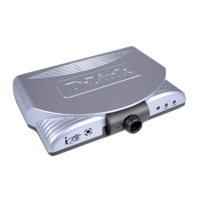
Do you have a question about the D-Link DVC-1000 and is the answer not in the manual?
| Protocols | H.323, SIP |
|---|---|
| Category | Telephone |
| Connectivity | Ethernet |
| Video Compression | H.263 |
| Type | Video phone |
| Ports | RJ-45 |
| Voice Codec Support | G.711 |
| Ethernet Ports | 1 x 10/100Base-TX |
| Display | 5.6 inch TFT LCD |
| Audio Codecs | G.711 |
Guides on operating the DVC-1000 using the included remote control.
Details the layout and functions of the remote control buttons.
Explains how to use the on-screen keyboard for text input during setup.
Guides the user through initial device setup with a step-by-step wizard.
Illustrates the main screen layout, status icons, and basic controls.
Guides on answering incoming calls and placing manual/speed-dial calls using handset or remote.
Explains speakerphone mode, switching calls, external mics, and privacy settings.
Guides on entering phone numbers and IP addresses for various call types.
Overview of the main screen and its interactive buttons: Dial, View, Settings, Privacy.
Describes speed dial, manual dial, and recent calls features within the Dial menu.
Explains how to customize the main screen display and view connection status.
Introduces settings for General, Personal Info, Network, Update, Video, and Mic Volume.
Details network configurations including Address, DNS, Public IP, Speed, and PING.
Covers configuring audio privacy, video privacy, and Do Not Disturb modes.
Guides on configuring the DVC-1000 with specific D-Link routers.
Explains the process of opening necessary ports for network functionality.
Discusses configurations for multiple IPs, single PC, multiple PCs with hub/router, and modem-only setups.
Addresses problems with dialing, IP calls, off-hook signals, busy signals, and registration.
Troubleshoots poor video, no video, video freezing, no audio, audio stopping, and echo.
Covers errors related to IP address detection, network speeds, system boot-up, and server issues.
Addresses issues with IP address acquisition, packet loss, and internet connection failures.
Explains i2eye, its features, and comparison to other videophones.
Covers port requirements, PC usage, wireless options, setup ease, and PC compatibility.
Discusses H.323 standards, privacy settings for managing calls, and call termination.
Defines terms like Bandwidth, DHCP, DNS, DSL, Ethernet, IP Address, NAT, TCP, UDP.
Defines video formats (CIF, QCIF, SQCIF), MAC, Router, DMZ, Ports, SLIC, WAN.
Details processor, standards, data rates, video, audio, camera, and physical specs.
Covers LED indicators, user interface, dialing, network, and electrical specifications.
Provides website and telephone contact details for technical assistance.